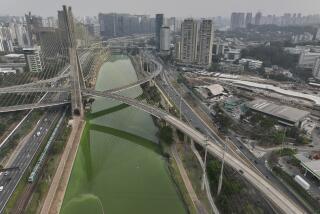Brazil’s water crisis amid drought could lead to rationing
A drought in Brazil has led to a water crisis and the country’s largest population center is facing the prospect of rationing.
Brazil’s Public Ministry, a federal regulatory agency, has recommended that Sao Paulo state immediately commence water rationing to avoid a “collapse of reservoirs,” but the state government missed an initial deadline on Wednesday to take action.
Because of scarce rain in 2014, water levels are low, especially at Sao Paulo’s Sistema Cantareira watershed. The Public Ministry says the watershed could soon run dry.
Residents all around the nation have complained of intermittent water shortages. In a June poll performed by Datafolha, 32% of Brazilians said they had experienced some sort of interruption to their water service in the previous month.
But the problem is worst in Brazil’s most-populous state, and a statement calling for immediate action, published by the Public Ministry on July 28, said that in Sao Paulo, a study “shows that the Sistema Cantareira could go totally dry in less than 100 days.”
Cantareira supplies about 45% of the metropolitan region of the city of Sao Paulo.
On Wednesday, a representative for the ministry said that Sao Paulo and Sabesp, its state water company, had missed the deadline and asked for an extension until Aug. 14 to either begin rationing or explain its refusal to do so. If another deadline is missed, the federal entity could begin legal action against the state, the representative said.
The crisis has come to dominate the reelection campaign of Gov. Geraldo Alckmin of Brazil’s right-of-center opposition PSDB party, and the state has been accused of conducting unofficial water rationing at night. Sabesp denies any rationing has occurred.
“While Sabesp recognizes the importance of the Public Federal Ministry ... the [rationing] measure would penalize the population and could lead to the opposite of what the regulators are hoping to achieve,” the water company said, adding that water has been transferred from other systems and residents who reduced usage had received a discount. “Sabesp guarantees the supply of water to the entire region until the arrival of the rainy season.”
Brazil is in the coldest part of its winter. The rainy season usually begins in November and is in full force in December.
Critics in Sao Paulo and across the country say the problems result from inefficient water treatments and a lack of investment in infrastructure to supply demand for water, which has increased in recent years. A study cited by Brazil’s Folha de S.Paulo newspaper estimates that regions representing 73% of the country’s water needs could face shortages over the next decade.
Businesses and households have already had to change tack in the city of Sao Paulo. In Vila Madalena, the onetime bohemian neighborhood that became the center of the city’s World Cup celebrations, some bars and restaurants, lacking water to clean them, have stopped serving drinks in glass cups.
Bevins is a special correspondent.
More to Read
Sign up for Essential California
The most important California stories and recommendations in your inbox every morning.
You may occasionally receive promotional content from the Los Angeles Times.










